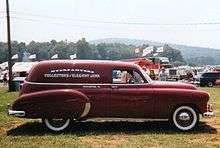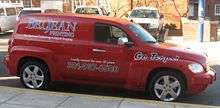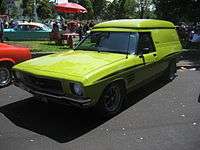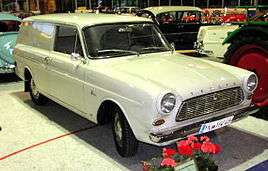Sedan delivery

A sedan delivery, commonly called a delivery in American English and a car derived van in British English, is a two-door station wagon with driver and front passenger seats or driver's only seat, and steel sheet-metal panels in place of rear side windows. Sedan deliveries have spartan interior trim and were used by businesses ranging from plumbers, couriers and local merchants such as bakeries as cargo vans are used today.
North America
Up to 1965


Plymouth produced a sedan delivery from 1935 until 1941. Pontiac produced deliveries until 1953 in the U.S. and until 1958 in Canada. This was possible because Canadian Pontiacs of the 1940s and 1950s actually used Chevrolet bodies; in fact, they are known to have used the rear sections of Chevrolet bodies through 1954 (creating odd Pontiac-Chevrolet hybrids; Pontiacs from the firewall forward, but with Chevrolet tail-lights). It may be Canadian Pontiacs of the 1940s similarly were Chevrolets at the rear, with Pontiac sheet-metal and trim at the front. These models were usually produced in very small numbers (200 or less); 449 Canadian Pontiac sedan deliveries were built in 1958.
The 1949-1952 Chevrolet sedan deliveries were attractive and dependable work vehicles. The 1957 150 series delivery is a valuable Chevy sought by collectors. From 1959 on, the sedan delivery was no longer practical; it was phased out in 1960 as a Chevrolet model, so the requisite Chevrolet body was no longer available.[1] Sedan deliveries were typically used as work vehicles, so they tended to wear out faster than a better cared for passenger car.
With the growing sales of the Volkswagen Type 2 and the introduction of compact vans, sedan deliveries faded from the scene. Chevrolet dropped the body type after 1960, while Ford moved it to the Falcon line-up until 1965.
1970s


Chevrolet and Ford offered subcompact sedan deliveries in the 1970s - The Chevrolet Vega Panel Express and the Ford Pinto Panel Wagon.
The Vega Panel Express was introduced in September 1970.[2] It was Chevy's first sedan delivery in ten years since the 1960 final full-size model. Chevrolet offered the rare body style Vega (less than 2% of its production) for the 1971 through 1975 model years.[3] First year sales peaked at 7,800 units; After leveling off to 4,000 units per year, only 1,525 1975 models were sold.[4]
The Pontiac Astre Panel, Pontiac's version of the Vega Panel Express, was available in Canada in the 1973-75 model years, and in the US for 1975.
The Pinto Panel Wagon was introduced in 1976 and was offered in both commercial and "factory customized" Cruising Wagon versions, featuring round port-hole rear side windows. The Courier name, previously used for Ford sedan delivery vans, had been dropped and applied to foreign pickup trucks.
2000s to present

In 2012, Ford of Europe introduced a Sedan Delivery configuration of the Ford Fiesta.[5] In 2007 Chevrolet released a Sedan delivery version of the HHR, marketed as the HHR Panel.[6]
Chrysler showed a concept car edition of a sedan delivery based on the PT Cruiser at the North American International Auto Show in 2002, but it was not manufactured.
Australia
Ironically while in decline in America, the delivery concept inspired Holden and Ford Australia to manufacture their own sedan deliveries, which evolved higher rooflines. Chrysler Australia also produced a few examples of the body style, including the Drifter. The Volkswagen Type 3 sedan delivery was also built (from CKD kits) and sold in Australia.
-
Chrysler CL Drifter Van
-
_Longreach_GLi_panel_van_(2015-06-03)_01.jpg)
Ford XG Falcon GLi Van
-

1953 Australian Holden FJ panel van with original Royal Mail paint work
-

Holden HQ Belmont Panel Van with Sandman option pack
Europe
In the past, deliveries were also popular in Europe. However, in the 1950s the larger sedan deliveries were replaced by vans like the Volkswagen Type 2, the DKW van and the first-generation Ford Transit. The smaller sedan deliveries continued; but now they are frequently replaced by small panel vans like the Renault Kangoo and the Opel Combo. Today, some station wagons like the Škoda Fabia, the Opel Astra or the final generation of the Ford Escort, can be ordered as a sedan delivery. There are also hatchback-based sedan deliveries like the Volkswagen Golf Mk2, the Volkswagen Polo Mk2, the Fiat Uno, the Peugeot 205, or the current Ford Fiesta.
The Škoda Octavia Praktik was sold exclusively in Austria as unique example of Octavia as commercial sedan delivery.
Car-derived vans may still offer some advantages over station wagons or vans. Taxes may be lower on a car-derived van with steel panels instead of the glazed windows of the original station wagon with rear seating.[7] Speed limits for a car-derived van may be higher than a similar vehicle built originally as a van.[8] This has given rise to some anomalies, such as the first Citroën Berlingo model. As this was first sold in the UK as a van, it's counted as a van-derived car and so does not have the speed advantage, despite the two vehicles being otherwise comparable.
|
See also
- Panel van (Australia) - (for more information on Australian sedan deliveries and the associated culture)
- Coupe utility
- Carryall
- Multi-stop truck
- Panel truck
References
- ↑ 1960-61 Chevrolet Full-Line Truck brochures
- ↑ 1971 Vega brochure-Sept. 1970
- ↑ 1971-75 Chevrolet Panel Express brochures
- ↑ h-body.org
- ↑ "Ford Brings Back the Sedan Delivery – New Fiesta Van for Europe". The Truth About Cars, December 28, 2012.
- ↑ Chevy introduces HHR Panel - Autoblog
- ↑ "What is a car, commercial vehicle or motor home for VAT?". HM Revenue & Customs (HMRC).
- ↑ "Speed limits and speeding". DirectGov. External link in
|publisher=(help)








